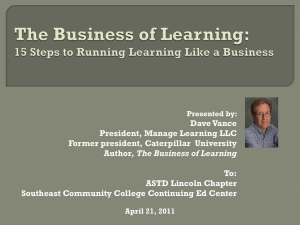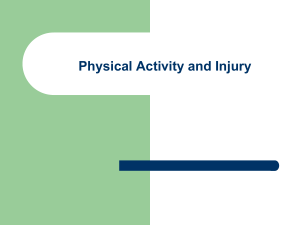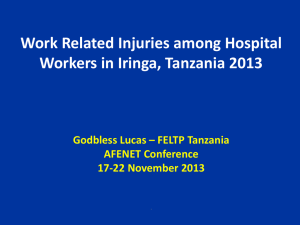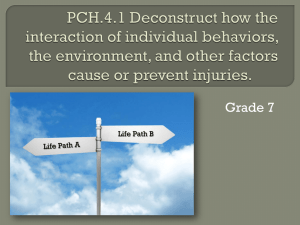Transmediastinal Injuries
advertisement
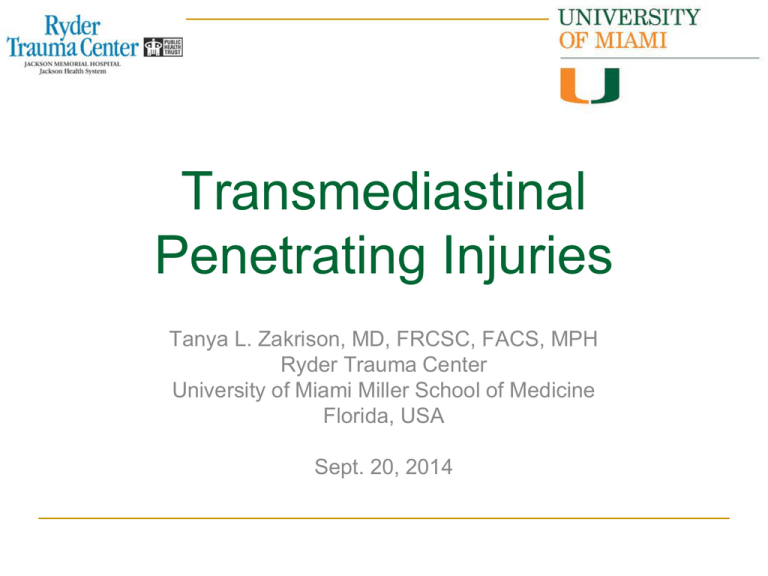
Transmediastinal Penetrating Injuries Tanya L. Zakrison, MD, FRCSC, FACS, MPH Ryder Trauma Center University of Miami Miller School of Medicine Florida, USA Sept. 20, 2014 Clinical Case – 24 male patient, found down in a ‘dangerous part’ of São Paulo EMS / Paramedics arrive He is breathing, has right-sided subcutaneous emphysema, blood pressure 90/50 mmHg and one obvious gun-shot wound on his chest 5th intercostal space, right side No other injury What is next? Paramedics Pre-hospital care most important is prompt transportation to a trauma center SCOOP AND RUN A - ETT – careful for tracheobronchial injuries B - Needle decompression for presumed (tension) pneumothorax Circulation – IV access, hypotensive resuscitation? D - Cervical or spinal cord injury – possible Exposure Difficult to diagnose in the field Unless one gun shot was heard, and 2 wounds on chest Nurses ATLS protocol in the trauma bay Work as a team, excellent communication Repeat the ABCDEs Verify ETT placement Help the surgeons place a tube thoracostomy on decompressed side Verify that the IV sites are in place, 20 cc/kg crystalloid Contralateral side too if still hypotensive Blood (massive transfusion protocol) ED thoracotomy? FAST & CXR Do we need to operate or not? ICU Care Look for occult injuries Missed after surgery Missed on CT scan Bronchoscopy Endoscopy Echocardiography Other tests Definitions Mediastinum: (Dorland’s Medical Dictionary) A median septum or partition The mass of tissues and organs separating the two lungs, between the sternum in front and vertebral column behind 1. 2. Transmediastinal Penetrating Injury / GSW (Richardson et al. 1981) Opposite hemithoraces have: Missle entry & exit wounds Missle entry & retained missile Traverse Mediastinal Gun Shot Wound Transverse Mediastinal Gun Shot Wound A transmediastinal penetrating injury does not necessarily mean a penetrating injury to the mediastinum Do we always have to operate? Anatomy: Mediastinum “Interpleural Space” Anatomy: Mediastinum “Interpleural Space” Mediastinal Contents Superior: Anterior: It contains a quantity of loose areolar tissue, some lymphatic vessels which ascend from the convex surface of the liver, two or three anterior mediastinal lymph glands, and the small mediastinal branches of the internal mammary artery. Middle: the aortic arch; the innominate artery and the thoracic portions of the left common carotid and the left subclavian arteries; the innominate veins and the upper half of the superior vena cava; the left highest intercostal vein; the vagus, cardiac, phrenic, and left recurrent nerves; the trachea, esophagus, and thoracic duct; the remains of the thymus, and some lymph glands. It contains the heart enclosed in the pericardium, the ascending aorta, the lower half of the superior vena cava with the azygos vein opening into it, the bifurcation of the trachea and the two bronchi, the pulmonary artery dividing into its two branches, the right and left pulmonary veins, the phrenic nerves, and some bronchial lymph glands. Posterior: It contains the thoracic part of the descending aorta, the azygos and the two hemiazygos veins, the vagus and splanchnic nerves, the esophagus, the thoracic duct, and some lymph glands. Anatomy: Mediastinum “Interpleural Space” Mediastinal Contents Superior: Anterior: the aortic arch; the innominate artery and the thoracic portions of the left common carotid and the left subclavian arteries; the innominate veins and the upper half of the superior vena cava; the left highest intercostal vein; the vagus, cardiac, phrenic, and left recurrent nerves; the trachea, esophagus, and thoracic duct; the remains of the thymus, and some lymph glands. It contains a quantity of loose areolar tissue, some lymphatic vessels which ascend from the convex surface of the liver, two or three anterior mediastinal lymph glands, and the small mediastinal branches of the internal mammary artery. Middle: contains the heart enclosed in the pericardium, the ascending aorta, the lower half of the superior vena cava with the azygos vein opening into it, the bifurcation of the trachea and the two bronchi, the pulmonary artery dividing into its two branches, the right and left pulmonary veins, the phrenic nerves, and some bronchial lymph glands. Posterior: It contains the thoracic part of the descending aorta, the azygos and the two hemiazygos veins, the vagus and splanchnic nerves, the esophagus, the thoracic duct, and some lymph glands. Other includes: azygous vein, thoracic duct, spinal cord What Do We Worry About As Surgeons? Injuries that kill early: Injuries that kill late: Tracheobronchial tree Injuries that kill if missed: Heart Great vessels Esophagus Azygous vein Injuries that cause morbidity: Thoracic duct Spinal cord Diaphragm Additional Concerns: Cardiac Box Associated Injuries: • Thorax: • Chest wall • Lungs Mediastinum Thoracoabdominal area • Abdomen: • Any structure • Timing of exploration important Asensio et al. World J Surgery, 2002 History of Penetrating Thoracic Trauma Described in the Edwin Smith Surgical Papyrus, dated 3000 BC, written by Imhotep First recorded “operation” for thoracic trauma in North America Cabeza de Vaca, 1635, described removal of arrowhead from the chest wall of an Native American Contemporary management of transmediastinal penetrating injuries required mandatory exploration Bradley M. Transmediastinal wounds. Am. Surg. 1966;32:847–852 Epidemiology of Penetrating Thoracic Trauma 150 000 people die a year secondary to trauma Urgent operative intervention only required in 2.8% of penetrating thoracic injuries BUT Mediastinal penetrating injuries have an increased need for operation 25% of deaths related to thoracic trauma Unstable: 43% of pts - 100% to OR Stable: 57% of pts - 35-60% to OR (Richardson et al., 1981) Management dictated by hemodynamic status But what does ‘stable’ mean? 2000 Can we triage patients based on blood pressure? (OR vs. investigations) Prospective, N = 68 Group I = SBP > 100 mmHg Dx: CXR > PE > OR Group II = SBP 60 – 100 mmHg Dx: CXR > PE > OR Group III = SBP < 60 mmHg Dx: ED thoracotomy > death > OR Conclusions: CXR with PE can diagnose TM GSW in 90% of pts. Indication for immediate OR in stable patients: massive hemothorax & hemopericardium 2000 SBP > 100 mmHg? SBP 60 – 100mmHg? Resuscitate (50% still do not need surgery) SBP < 60 mmHg? Investigate (60% do not need surgery) Operate (100% need ‘surgery’) Remember: 1/5 have an intraabdominal injury Injury, 2013 Prehospital transport times are better More patients with TGSW are surviving to hospital They are ‘sicker’ 87% were unstable on arrival (including VSA) 84% required an ED thoracotomy (6% survival) Only 8% managed non-operatively Overall mortality 79% If arrived with vital signs: 24% Main Message Get your ED thoracotomy tray ready Some stable patients need to go to the OR Half (or less) will need surgery Positive pericardial FAST or massive hemothorax Even if unstable, but all if in extremis Don’t forget the abdomen Algorithm for All Transmediastinal Injuries In Extremis: 1. ED thoracotomy Hemodynamically unstable: 2. CXR, FAST, bilateral chest tubes To the OR Hemodynamically stable: 3. Diagnosis (CTA) Trajectory & injuries Management Surgical vs. non-operative How Do We Investigate the Stable Patient? Can helical CT scan reduce the need for further investigations? N = 24 pts. mediastinal GSWs, HD stable All pts. received a helical contrast CT scan 12 pts. required further imaging Bullet tract close to mediastinum – to OR All other studies negative, no missed injuries Conclusion: 50% of pts. had a change in management based on CT scan Helical CT effective to evaluate missile trajectories to assess for mediastinal injuries and avoid unnecessary exams Algorithm for Stable Transmediastinal Injuries Overt Injuries: Heart, great vessels Occult Injuries: To OR Heart, great vessels Tracheobronchial tree Esophagus Azygous vein Thoracic duct Patients with negative helical CTAs can be safely observed What is our local experience with investigating TM GSWs in stable pts.? Work up depends on trajectory NO CTA Prospective, N = 50 pts. All pts. had a CXR followed by either: Cardiac ultrasound, angiography, esophagoscopy, barium swallow and bronchoscopy 8 pts. (16%) found to have a mediastinal injury (cardiac > vascular > tracheoesophageal) 42 pts. (84%) had no mediastinal injury • No difference between groups re: biochemical or clinical status (including chest tube outputs) Stable pts. may have life-threatening, occult injuries Aggressive work-up needed in all to avoid missed injuries Burack JH, et al. Triage and outcome of patients with mediastinal penetrating trauma, Ann Thorac Surg. 2007 BACKGROUND: What is our experience with CXR, ECHO & CTA scans in the evaluation of stable patients with mediastinal penetrating trauma? METHODS: Retrospective study, N = 207 Unstable patients: OR Stable patients: CXR, TTE and CTA. Further testing (angiogram, bronchoscopy, esophagoscopy, esophagogram) based on trajectory RESULTS: 35% were unstable, 26% died in the emergency department CTA evaluation was normal in almost 80% of patients no further treatment needed Occult injury found in 7% of stable patients CONCLUSIONS: Unstable patients require surgery Stable patients: TTE & chest CTA are effective screening tools Patients with a negative TTE and CTA results can be observed If TTE or CTA positive, exclude occult injury After thoracic CT scan Esophagoscopy Esophageal swallow Bronchoscopy Angiography Mandatory pericardial window OR: Selective investigation depending on the trajectory of the bullet 83% of stable pts. had negative CTAs with no missed injuries In the Stable Patient: Is this a transmediastinal penetrating injury? 1. CXR & physical exam 1. Are mediastinal structures injured? 2. Overt injuries requiring OR? 1. CXR: massive HTX FAST: positive presumed hemopericardium 1. 2. Occult injuries requiring OR? 2. CTA: trajectory 1. 1. 2. 3. 4. Airways Esophagus Vessels Heart 1. Left HTX; false negative FAST How Do We Operate? Operative Approach What is injured? Great Vessels Massive hemothorax (unilateral or bilateral) Large mediastinal hematoma on CXR Heart FAST positive FAST indeterminate, false negative ? Left hemothorax Ongoing blood loss from chest tube Both Both +/- other organs Other organs (massive tracheobronchial injury) Great Vessel Injury: Where to Cut? Great Vessel Injury: Where to Cut? Transmediastinal Injuries Don’t forget about the abdomen! Asensio JA, Arroyo H Jr, Veloz W, Forno W, Gambaro E, Roldan GA, Murray J, Velmahos G, Demetriades D. Penetrating thoracoabdominal injuries: ongoing dilemma-which cavity and when? World J Surg. 2002 May;26(5):53943. N = 254 patients penetrating thoracoabdominal injuries 20% underwent combined thoracotomy and laparotomy Mortality doubles if combined procedures are required Persistent hypotension more often in laparotomy followed by thoracotomy group but numbers are too small Watch persistent hypotension and misleading chest tube outputs Where to Cut? Median Sternotomy Principles: “Anywhere you need” Median Sternotomy +/- cervical extension (R or L): R subclavian artery, proximal R carotid, brachiocephalic artery, proximal L carotid artery NOT GOOD FOR L subclavian artery Too far posterior 3rd ICS anterolateral thoracotomy for proximal control Supraclavicular incision with resection of medial 3rd of clavicle (distal control) Median sternotomy (to join the incisions – book / trap door) Rarely used GOOD FOR concomitant cardiac injuries Where to Cut? Bilateral Anterolateral Thoracotomies Utility incision, access to heart and aorta for resuscitation Can access right lung hilum, ascending aorta, right subclavian vessels However problematic for L subclavian artery injuries J Am Coll Surg 1999; 188:290-295 Retrospective review N = 79 pts. with penetrating subclavian or axillary artery injury Conclusion: Clavicular incision alone provides adequate exposure in 50% of pts. (R and L) In proximal injuries can use the addition of medial sternotomy More deaths seen with SCV injuries than SCA Great Vessels – Surgical Principles Great vessels are fragile, tear easily with dissection, therefore oversew proximal injury on aorta, sew graft into new location on aorta without tension Use prosthetic graft for vessels > 5 mm vs. saphenous vein (pseudoaneurysm vs. acute rupture) Dacron for fragile vessels – aorta, SCA Subclavian Artery Injuries Pitfalls for SCA: Watch injury to phrenic nerve when dissecting out SCA Failure of proximal control with 3rd ICS Failure to document brachial plexus status pre-op No tunica media, end to end anastomosis doomed to fail – Interposition graft Damage control: 1. 2. Definitive repair of injuries with quick & simple techniques in one operation Abbreviated thoracotomy to restore survivable physiology during a single operation Cardiac Injuries Unstable pts. may present with tamponade or ongoing blood loss from chest tube Occult cardiac injuries may be present in 5% to 10% of patients after a TM-GSW Feliciano D, et al. J. Trauma 2000;48:416–422 TTE is the diagnostic test of choice in patients with wounds traversing the anterior mediastinum When ECHO is used to screen for pericardial fluid it is 97% sensitive, 100% specific, and 99% accurate Nagy K, et al. J. Trauma 1995;38:859 – 862 Esophageal Injuries Incidence 0.7% after thoracic gun shot wounds Transmediastinal gun shot wounds close to spine may result in through and through injury Delay in repair disastrous Upper 2/3rds of thoracic esophagus: Distal 1/3: Right posterolateral thoracotomy Left posterolateral approach (7th ICS) Primary repair even if > 24 hrs Grillo pleural patch & decortication How long is too long when investigating esophageal injuries? Retrospective, multicenter study, N = 45 pts. All pts. to OR, pre-operative evaluation vs. no evaluation 13 hrs vs. 1 hr Increased complications, LOS in group evaluated (OR > 3) Conclusion: Esophageal injuries carry high morbidity and mortality. Diagnostic testing, if done, should be expeditious with delays to definitive management reduced. Tracheobronchial Injuries Conservative: Small injuries (< 1/3 diameter of airway) Asymptomatic Controlled with tube thoracostomy No need for PPV Operative: R posterolateral thoracotomy for injuries of: Intrathoracic tracheal, right bronchial, and proximal left mainstem bronchus or complex bilateral injuries L posterolateral thoracotomy for injuries of: Or place ETT beyond injury with cuff inflated below Distal left bronchial injuries > 3 cm from carina Mobilize anterior and posterior trachea as needed Interrupted, absorbable sutures (4-0 Vicryl), sutures tied on the outside, end to end anastomosis Buttress repair with intercostal muscle Suture chin to chest for healing Follow up: Pre-op baseline flow-volume loops Beware later presentation of ‘adult asthma’ stricture Tracheobronchial Injuries Special Problems Bullet embolization Thoracic duct injury Spinal cord Azygous vein Bullet (Foreign Body) Embolization Bullet entry into large diameter vessels of chest Diagnosis frequently delayed as course of bullet not always apparent Usually lodges in femoral or iliac vessels Control site of entry for hemorrhage first Remove bullet emboli Surgery Endovascular methods Special Problems Thoracic duct leaks: Chylothorax Spinal cord injury Always assess neurologic function pre-operatively Neurogenic shock may occur C > T > L spine Azygous Vein Injury and Repair N = 22 patients over 40 years Mortality 36% Maintain an index of suspicion when there is continued dark venous ooze from behind the pulmonary hilum Posterolateral thoracotomy best exposure Ligate the vein unless no IVC In Conclusion: Is this a transmediastinal penetrating injury? 1. CXR & physical exam 1. Is your patient unstable? 2. YES: Bilateral chest tubes, FAST, ED thoracotomy / OR NO: investigate 1. 2. Are mediastinal structures injured? 3. Overt injuries requiring OR? 1. CXR: massive HTX FAST: positive presumed hemopericardium 1. 2. Occult injuries requiring OR? 2. CTA: trajectory 1. 1. 2. 3. 4. Airways Esophagus Vessels Heart 1. Left HTX; false negative FAST tzakrison@med.miami.edu ¡Muito obrigado!




